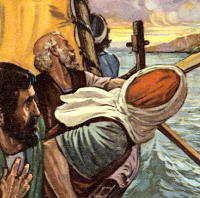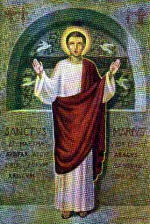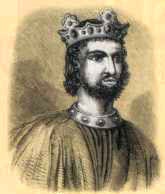
Daily Readings for: January 19, 2012
(Readings on USCCB website)
Collect: Almighty ever-living God, who govern all things, both in heaven and on earth, mercifully hear the pleading of your people and bestow your peace on our times. Through our Lord Jesus Christ, your Son, who lives and reigns with you in the unity of the Holy Spirit, one God, for ever and ever.
RECIPES
ACTIVITIES
PRAYERS
Ordinary Time: January 19th
Thursday of the Second Week of Ordinary Time Old Calendar: Sts. Marius, Martha, Audifax, and Abachum, martyrs; St. Canute, martyr
According to the 1962 Missal of Bl. John XXIII the Extraordinary Form of the Roman Rite, today is the feast of Sts. Marius, Martha, Audivax and Abachum, a group of Roman martyrs of the third century. St. Canute was king of Denmark; he was put to death out of hatred of his faith and his zeal in working for its extension in his kingdom. He was killed in St. Alban's Church in Odense.
The Week of Prayer for Christian Unity
St. Marius and Family Their feast does not appear in the Roman calendar until the twelfth century. The Acts of these martyrs are wholly legendary. They give the following details. Marius was a Persian of noble extraction. With his wife, who was also noble-born, and his two sons, Audifax and Abachus, he came to Rome during the reign of Emperor Claudius II (268-270) to venerate the graves of the martyrs. They visited the Christians in prison, encouraged them by word and deed, and shared with them their goods. And like Tobias of old, they buried the bodies of the saints.
Their feast does not appear in the Roman calendar until the twelfth century. The Acts of these martyrs are wholly legendary. They give the following details. Marius was a Persian of noble extraction. With his wife, who was also noble-born, and his two sons, Audifax and Abachus, he came to Rome during the reign of Emperor Claudius II (268-270) to venerate the graves of the martyrs. They visited the Christians in prison, encouraged them by word and deed, and shared with them their goods. And like Tobias of old, they buried the bodies of the saints.
It was not long before they themselves were arrested; and when neither threats nor allurements could make them offer sacrifice to the idols, they were savagely flogged. Martha was the first to die, but not before she had fervently exhorted her husband and sons to endure steadfastly whatever tortures might be inflicted for the faith. All were beheaded in the same place and their bodies thrown into the fire. Felicitas, a saintly Roman woman, succeeded in recovering the half-burnt bodies and buried them on her estate.
St. Canute St. Canute, king of Denmark, was murdered in St. Alban's Church, Odense, July 10, 1086. The Martyrology confuses him with his nephew, St. Canute the Duke, who died on January 7, 1131, and was canonized November 8, 1169, by Pope Alexander III. St. Canute is also called Canute the holy, or Danish Knut, or Knud, Den Hellige, or Sankt Knut, or Knud.
St. Canute, king of Denmark, was murdered in St. Alban's Church, Odense, July 10, 1086. The Martyrology confuses him with his nephew, St. Canute the Duke, who died on January 7, 1131, and was canonized November 8, 1169, by Pope Alexander III. St. Canute is also called Canute the holy, or Danish Knut, or Knud, Den Hellige, or Sankt Knut, or Knud.
The son of King Sweyn II Estrithson of Denmark, Canute succeeded his brother Harold Hen as king of Denmark. Canute opposed the aristocracy and kept a close association with the church in an attempt to create a powerful and centralized monarchy.
In ecclesiastical matters, Canute generously patronized several churches, including the Cathedral of Lund, Denmark's archbishopric; established a Benedictine abbey at Odense; and supported apostolic preaching throughout Denmark. In temporal matters, he attempted an administrative reform, particularly an enforced levying of tithes that incurred the wrath of the rural aristocracy. In 1085 he reasserted the Danish claims to England and, with the count of Flanders and King Olaf III of Norway, prepared a massive invasion fleet that alarmed the Norman-English king William I the Conqueror.
Canute's plan, however, had to be abandoned suddenly, for those aristocrats who opposed his tax policy revolted as he was preparing to embark for England. He fled from the rebels, led by his brother Prince Olaf, to St. Alban's Church, Odense, which he had founded, and was assassinated there with the entire royal party.
Canute was buried in St. Alban's, renamed c. 1300 St. Canute's Cathedral. Miracles were recorded at his tomb, and, at the request (1099) of King Erik III Evergood of Denmark, he was canonized (1101) by Pope Paschal II.
Patron: Zeeland, Denmark.
Symbols: Knight with a wreath, lance, and ciborium.

The Week of Prayer for Christian Unity
Eight Days reflecting on our change in Christ
Day Two: Changed through patient waiting for the Lord
Let it be so now, for it is proper to fulfil all righteousness (Mt 3:15)
On this day we concentrate on patient waiting for the Lord. To achieve any change, perseverance and patience are needed. Prayer to God for any kind of transformation is also an act of faith and trust in his promises. Such waiting for the Lord is essential for all who pray for the visible unity of the church this week. All ecumenical activities require time, mutual attention and joint action. We are all called to co-operate with the work of the Spirit in uniting Christians.